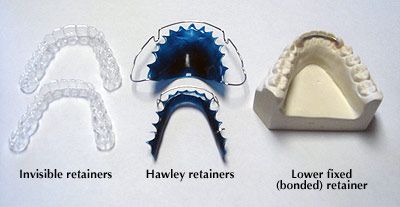The entire prospect of wearing an orthodontic retainer after you get your braces off could seem quite frustrating. But an important step follows the treatment with braces.
That’s right, upon complete treatment with braces, it’s normal for your teeth to shift once again after the removal of braces.
As you wear retainers, your teeth will remain firm in their new position. This will remain so for a long time, leading to the best results ultimately.
Sometimes, orthodontic patients have to wear a retainer on the top or bottom of the teeth. But sometimes patients could need to wear them both.
At first, you will have to wear the retainer all through the day, and most likely, you will have to wear it at night as well when you want to sleep.
Just remember that the treatment plan of every individual would vary in a different way. This is something that also depends on the orthodontic training programs that specialists go through.
Table of Contents
What are the Orthodontic Retainer Types?

Image Courtesy: impressionsorthodontics.com
In general, retainers are available in two common types, fixed and removable.
Usually, the removable ones are the types patients wear for at least a year, while fixed ones are the types they can wear for several years.
The fixed retainers adhere well to the back of the teeth with cement. The materials used to manufacture retainers typically include:
- Clear: These consist of molded clear plastic that fits properly over the teeth, since they are not noticeable and remain a popular choice amongst adults.
- Acrylic: These are also common retainers and made with acrylic, bendable wire, and easy to adjust. These are also available in various styles and colors.
Fixed Retainers
For some extra peace of mind, you can choose fixed retainers.
As their name suggests, these consist of thin stainless steel wire, which bonds permanently behind the front set of teeth.
These are unobtrusive and you will forget they are actually there. You should just ensure that you extra care while brushing them.
Your orthodontist will be able to guide you on how to care for it.
Removable Retainers
Removable ones often resemble a clear gum shield that is thin and fit snugly over your teeth at all times to keep them in the right position.
Sometimes, they are not noticeable, comfortable, and custom-made to fit you perfectly.
When you seek the help of an experienced orthodontist who goes through Gerety Orthodontic Seminars, they will take impressions of your teeth and fit retainers.
Furthermore, orthodontists will advise you on the right time to wear your removable retainers.
In most cases, you should try to keep them safe when you do not wear them. These also have the tendency to disappear so you should have a spare one.
Why Do Teeth Move After Treatment with Braces?
During the treatment with braces, your teeth will remain in the same position by the braces. But after removal, elastic fibers in the gum will need stretching to get the teeth back to their original position.
In medical terms, this is related to the term “orthodontic relapse.”
It will take time for these fibers to stop pulling on the teeth.
When the jaw grows continuously, this will encourage the teeth to move with treatment completion. To help with orthodontic relapse, patients will need retainers, which help to keep teeth firm in their new position.
After the removal of the braces, you will be at risk of tooth relapse.
However, over time, your teeth will then stabilize, but this will not mean that you can stop wearing the retainers over a few months.
In order to guarantee that your teeth stay in the right position, retainers are what you need for a lifelong commitment.
The good thing is they are both discreet and comfortable.
Interesting read: Compressed Coin Tissues – Next-gen secret of better hygiene.
What to Expect from Ortho Retainer
Similar to wearing braces, when you wear retainers you may feel some pressure and experience soreness as your mouth would adjust to the retainer.
In case the retainer causes some pain or cuts into your gums, you shouldn’t waste time and consult your orthodontist as soon as possible. It’s possible that it needs the right adjustment.
For the first few days, it’s completely normal for you to experience some problems with your speech. You should try to talk slower when wearing the retainers.
These also work to stimulate the production of saliva in the mouth; you shouldn’t worry because this is something completely normal.
Caring for Retainers
At all times, you should make sure that you keep your retainers clean.
It’s possible for bacteria, plaque, and leftover food particles to remain stuck on it so try to keep it clean.
If you have acrylic retainers, make sure that you rinse them out with warm water and this should help to get rid of the buildup of bacteria.
Once a week, you should disinfect your retainers by soaking them in distilled water with some baking soda. Your
Avoid the use of toothpaste that has harsh chemicals or cleaners. Rinse the orthodontic retainers with warm water and make sure you keep them in one place at all times.
Interesting read: Is Bronchitis Contagious?






